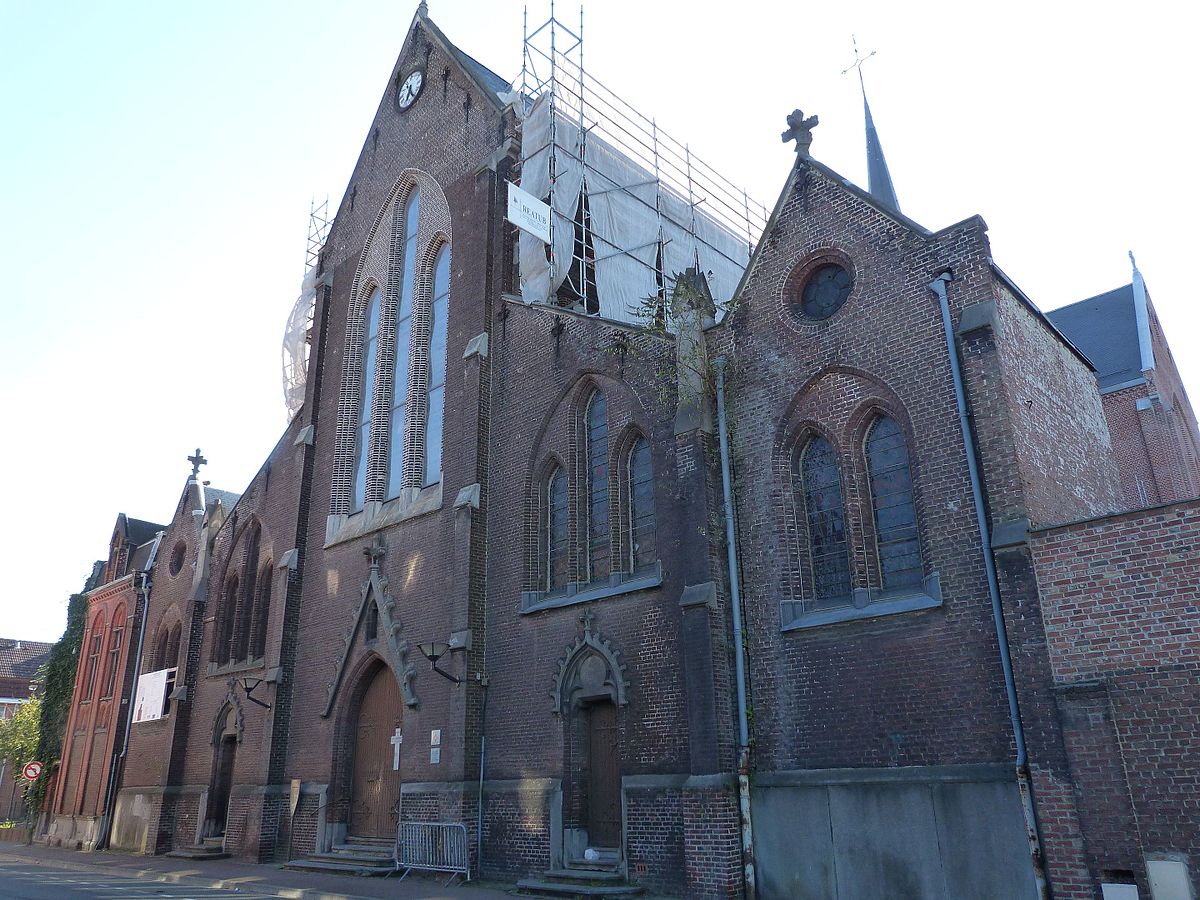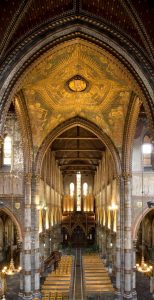*by Gilles Guey
The Church of Saint Joseph, located in the city of Roubaix in northern France, was inaugurated in 1878. It was designed by Lord Jean-Baptiste Bethune, a Belgian architect and disciple of Viollet-le-Duc and Pugin.

Façade de l’église Saint-Joseph, octobre 2016
Though clearly the product of Lord Bethune’s design, this neo-gothic masterpiece is also the result of a collaborative effort, the decoration having been carried out by a number of artists and craftsmen, such as Claudius Lavergne for some of the stained glass, Hendrik Jozef De Block for the pulpit, the organ case, the side altars and most probably the stalls, Pierre Schyven for the organ, the Desclée company for the baptismal font and Jan Willem Deumens for the mural paintings.
In spite of this, the architecture and the splendid decor of Saint Joseph’s Church has not always brought it the recognition it rightly deserves. Perhaps because Lord Bethune is not well-known in France; perhaps also because the renewed interest for the neo-gothic movement is too recent in our country; or perhaps because the Christian community in the neighbourhood is not as large as it used to be, this church in time fell into oblivion. The building itself was neglected and became damaged. The worst occurred when, during the terrible storm of 2007, some of the stained glass windows were shattered.

The Church of Saint Joseph, Roubaix. Author: Siméon Levaillant
But thanks to the involvement of volunteers, including the successive presidents of the Compagnons de Saint-Joseph association – Véronique Lenglet, Yves Ducrocq and Marie-France Jaskula – the attention of the press, of local councillors, of citizens and of art historians was drawn to this splendid church.
The restoration process was thus launched in 2009 starting with the stained glass windows. Today it can be confidently confirmed that this will ultimately lead to the complete renovation of the building by 2019-2020, including certain pieces of the church’s furniture.
The church will then recover its former splendour, its colours and its gilt. It will become an attractive building at the centre of Roubaix’s northern zone. The church is situated between two extremely interesting districts. One, called l’Alma, was totally transformed in the 1970s and is today a rather low-income district. The other is called l’Union and is currently undergoing full renovation. In the end, this latter district will host up to 250,000 square meters of space for companies and 1400 new lodgings.
The church is thus located in a fast-changing zone, and the issues surrounding its renovation are all the more important.
One objective is to restore parish life as soon as the church reopens.
The building was listed in 1993 and, when it reopens, it should attract an ever-increasing number of art lovers. Roubaix’s heritage is very rich. It includes Saint Joseph’s Church and many other exceptional buildings. These include La Piscine, one of France’s most important museums; it is located in a converted art deco swimming pool. One other such example is the fantastic gymnasium located in the rue de Chanzy; Le Gymnase houses a centre for choreography. Roubaix is a former textile city, which is now being transformed. Several universities have opened there, and companies specializing in new technologies have come to settle. Tourism also plays a very important role in the city – Saint Joseph’s church will no doubt soon be part of tours including other towns and buildings in the neighbourhood, such as Mallet-Stevens’ Villa Cavrois in Croix or Saint Teresa’s Chapel in Hem.
When it reopens, the church will once again be an important centre for music, as it already had become before it closed for renovation in 2012. The members of the Compagnons de Saint-Joseph organised several concerts there every year. Furthermore, the choir school and sometimes the church itself hosted rehearsals for the musical groups which participate in the Chapelle des Flandres association; these included Les Métamorphoses, which is dedicated to ancient and contemporary music and perform high-quality concerts. The group has made several exceptional recordings, many of which have won awards.
Obviously, it is impossible to organise concerts in the church during the renovation. That said, the connection with the artists who have performed there has not been lost. La Chapelle des Flandres rehearsals take place not far from the church for the time being. The municipality also wants to invite visual artists to create pieces of contemporary art in relation to the church. The idea is that they should produce multiple pieces. One of them would be displayed in the church or in the sacristy, and the others would be presented to the primary sponsors of the Saint Joseph project. Nicolas Tourte, a visual artist whose workshop is situated in Roubaix, was the first to be invited to create a piece for Saint Joseph; he created a work entitled Les ailes du désir (The wings of desire). Naturally, other artists will soon be invited to participate as well.
Bringing in a contemporary perspective on the building is very important for the municipality. For this reason, Siméon Levaillant was commissioned to create a series of photographs related to the church. This initiative resulted in the book Le baron Bethune à Roubaix (Lord Bethune in Roubaix), published by Invenit in 2014.
The renovation process of Saint Joseph’s Church is no doubt a great success. This is certainly due to that fact that all those involved have gone back to the spirit of its creator, Lord Bethune. Right from the onset, Saint Joseph’s was a shrine for the fine arts and the applied arts. The building, when seen from the outside, may be considered plain and unobtrusive, but each and every part of the inside is painted; it contains numerous pieces of art and is flooded with the colours from the stained glass. A number of craftsmen continue to work on this building yet today. It is a source of inspiration for visual artists and will soon be a shrine again for musical events.
Today, a team is working on the building, as was the case 140 years ago. In the 19th century, there was Lord Bethune team and, after his death, Father Lesage’s team. Today, the team is composed of many volunteers and professionals; of the architect Vincent Brunelle; of different companies and local councillors; of the Mayor, Guillaume Delbar, who, following his predecessors René Vandierendonck and Pierre Dubois, has taken up the project; of the municipality staff; of the Compagnons de Saint-Joseph association; of La Sauvegarde de l’Art Français, presided by Olivier de Rohan Chabot; of sponsors involved in Le Cercle des Mécènes de l’Eglise Saint-Joseph presided by Damien Debosque; of the parish; and of artists, La Chapelle des Flandres, photographer Siméon Levaillant, writers and researchers involved in the publication of the book on Lord Bethune.
They are all part of a collective which is very much involved in the restoration process, and all of them support it with great enthusiasm. They are determined to complete the project successfully, to bring back the church to life, to restore its splendour for the benefit of the inhabitants of Roubaix and of all those who will wish to pray there, visit the building or simply enjoy its artistic events.
Renovating the Saint Joseph’s Church means reviving the creative spirit of Lord Bethune. It is also a wonderful story of people, the story of a team which, with determination and passion, wants to bring the project to successful fruition.
Restoring the church, finally, is a new step for Roubaix’s involvement in the renovation of its heritage. After successfully renovating its industrial heritage, its service buildings (the swimming pool and gymnasium), the City of Roubaix now has a duty to restore its religious heritage and, in part, convert it. To be sure, parish life will be rekindled at Saint Joseph’s once the church reopens. But Roubaix has yet to invent a new use for its splendid Clarisses convent (another work by Lord Bethune) or for Our Lady’s Church. The municipality is working on it right now, hoping to bring new projects to life within the framework of European ones.

*After pursuing studies in French literature, Gilles Guey started his career as a teacher. Soon thereafter, however, he came to concentrate on cultural affairs and was given charge of three projects for the French Ministry of Foreign Affairs. He started as cultural officer at the French Cultural Centre in Malawi, and then became director of the Alliance Française, first in India and then in Mexico. He returned to France in 2005 and became director of Cultural Affairs in Noisy-le-Sec, near Paris. In 2009, he became director of Cultural Affairs for the City of Roubaix. Gilles Guey is Associated Member of FRH.





Follow us: